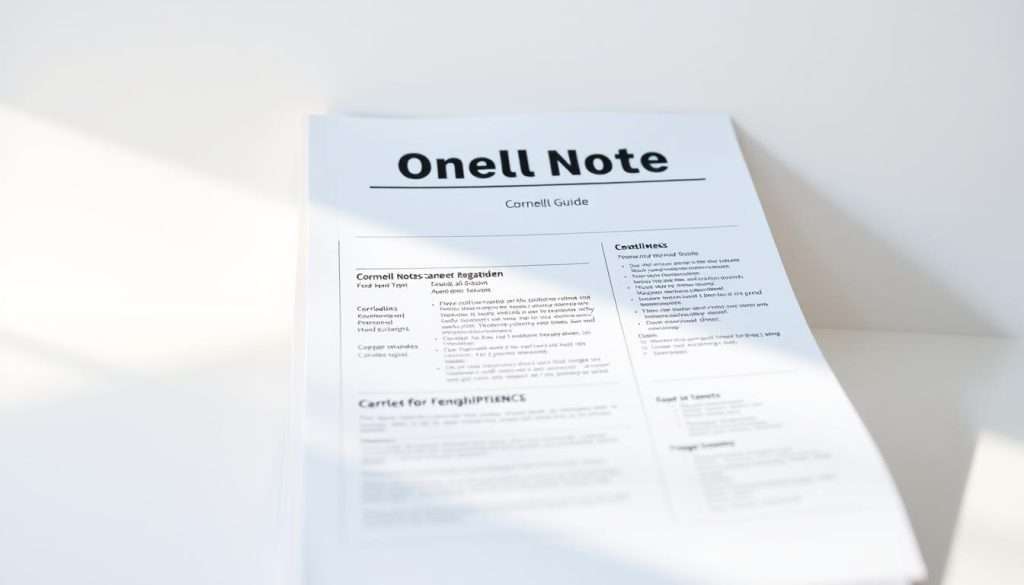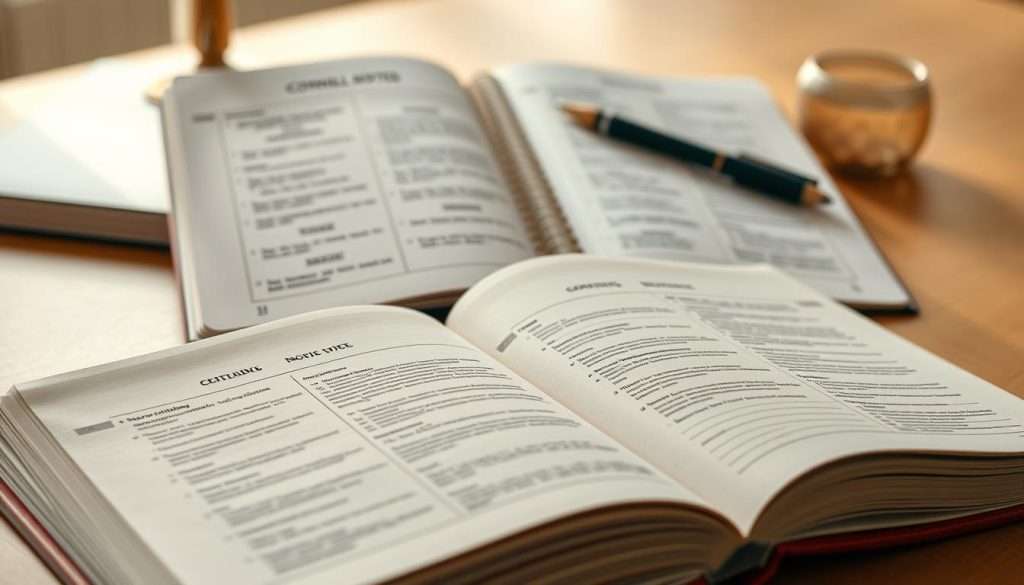Welcome to our guide on the Cornell Note-Taking Method! We’re excited to share its benefits. This method was developed at Cornell University.
Using the Cornell notes system can speed up your note-taking. It also helps you absorb information better. This method is more than a technique; it’s a tool to unlock your full potential as a learner.
By the end of this article, you’ll know how to improve your learning and retention. We’ll show you how this method can help you engage more deeply with the material. You’ll also learn how to organize and review your notes efficiently.
Key Takeaways
- Discover the benefits of the Cornell note-taking method for effective learning.
- Learn how to organize your notes using the Cornell notes system.
- Understand how to review your notes efficiently to retain information.
- Unlock your full potential as a learner with this systematic approach.
- Transform your learning and retention abilities with the Cornell Note-Taking Method.
What Are Cornell Notes?
The Cornell Notes system was created at Cornell University. It’s a method for taking notes that has helped many students. It divides the page into sections to fit different learning styles.
The Origin and Development of the Cornell Method
Developed years ago, the Cornell Notes system aims to improve note-taking. It offers a structured way to capture and review information. Its simplicity and effectiveness make it a favorite among students.
Core Components of Cornell Notes
The Cornell Notes system has three key parts: cues, notes, and summary.
– The cues column is for keywords, questions, or prompts to guide review.
– The notes section is for recording main information during lectures or reading.
– The summary area helps recap key points, improving understanding and retention.
This system offers a detailed approach to note-taking. It boosts learning and retention. It’s also flexible, fitting various subjects and learning settings.
The Powerful Cornell Notes: Why This System Works
Ever wondered why Cornell Notes are so effective? It’s because they tap into how our brains work. The Cornell Notes system is based on cognitive psychology, making it a top choice for learning.
Scientific Basis for the Method’s Effectiveness
The Cornell method uses the psychological spacing effect and active recall. These help you remember and understand better. By breaking your notes into cues, notes, and summaries, you actively engage with the material. This structured way improves retention and recall.
- Utilizes the psychological spacing effect for better retention
- Promotes active recall through cues and summaries
- Enhances engagement with the study material
Cognitive Benefits of the Cornell System
The Cornell Notes system has many cognitive benefits. It improves memory, organizes information, and enhances understanding through summaries. By using this system, you can:
- Improve your recall by creating cues that trigger memory
- Organize information hierarchically, making it easier to review
- Enhance your understanding by summarizing the main points
This method is more than just note-taking. It’s about connecting with the content and making it your own.
Setting Up Your Cornell Notes Template
Let’s explore how to set up your Cornell Notes template. It’s a simple yet effective tool for learning. You can make it digital or physical, as long as it has the right sections.
The Essential Layout: Cues, Notes, and Summary Areas
The Cornell Notes template has three main parts: cues, notes, and summary. The cue column is for keywords, questions, or prompts. It helps you remember the information. The notes section is for the main content. And the summary area is for the key points.
Proper Proportions for Each Section
The cue column should be about 2.5 inches wide. The notes section should be about 6 inches. The summary area should be about 2 inches tall at the bottom. You can adjust these sizes based on your needs.
Header Information to Include
At the top, write the date, topic, and any relevant context. This helps organize your notes and provides context when reviewing.
Digital vs. Physical Cornell Notes Templates
You can use digital tools like Microsoft Word or OneNote, or a physical notebook. Digital tools are flexible and easy to edit. Physical notebooks offer a hands-on experience. Pick what works best for you.
Step-by-Step Guide to Taking Cornell Notes
Now that you have your Cornell Notes template ready, it’s time to master the technique. Taking Cornell Notes involves preparation, active engagement, and review. Let’s break down each step to ensure you’re getting the most out of this powerful method.
Before the Lecture or Reading
Before you start taking notes, prepare your template. Fill in the date, topic, and any relevant context. Reviewing any available materials beforehand can also help you understand the context better and make your note-taking more effective.
- Review any pre-lecture materials or assignments.
- Prepare your Cornell Notes template with the necessary headings.
- Mentally prepare yourself to engage with the material.
During the Information Intake
During the lecture or while reading, focus on capturing key information in the Notes section of your template. Use short sentences, abbreviations, and symbols to keep up with the pace. Don’t worry too much about grammar or spelling at this stage; the goal is to capture the essence of the information.
- Use bullet points or numbered lists to organize information.
- Highlight or underline key terms and concepts.
- Leave space for future reference or additions.
After the Lecture: Review and Summarize
After the lecture or reading, review your notes to fill in any gaps, clarify unclear points, and summarize the main ideas in the Summary section. This step is crucial for reinforcing your learning and aiding retention.
| Action | Purpose |
|---|---|
| Review notes within 24 hours | Reinforce learning and fill gaps |
| Summarize main ideas | Aid retention and understanding |
| Use the Cue Column for review | Test recall and reinforce memory |
By following these steps, you’ll be able to take full advantage of the Cornell Note-Taking Method. This will enhance your learning experience and improve retention.
Mastering the Cue Column: Creating Effective Prompts
Mastering the cue column is key to getting the most out of the Cornell Notes system. The cue column acts as a mental trigger, helping you remember information better. By crafting good prompts, you can make studying more efficient.
The cue column helps you link cues to the notes you’ve taken. This link is crucial for better memory recall. We’ll explore different cues, how to create them, and give examples of their effectiveness.
Types of Effective Cues
Effective cues can be keywords, questions, or visual symbols. They should be relevant and brief. For example, using keywords related to the topic can help you remember it faster. Questions are also great as they make you think deeply about the material.
Using Questions to Enhance Recall
Using questions as cues is a smart strategy. Questions make you actively recall information, which helps you understand it better. For instance, instead of just “Revolution,” ask “What were the main causes of the French Revolution?” This improves both recall and comprehension.
“The art of remembering is the art of being able to recall the right information at the right time.”
Examples of Strong vs. Weak Cues
Let’s look at examples to see what makes a cue strong or weak. A weak cue is vague, like “History.” A strong cue is specific, like “Causes of World War II.” Here’s a table to show the difference:
| Weak Cue | Strong Cue |
|---|---|
| Economics | Keynesian Economics Principles |
| Science | Mitosis Process in Cell Biology |
| History | Impact of the Industrial Revolution |
Using specific cues can greatly improve your memory. This makes your study time more productive and effective.
The Notes Section: Capturing Information Efficiently
To get the most out of the Cornell note-taking system, you need to know how to capture information efficiently in the notes section, so let’s dive in. The notes section is where you’ll record main ideas and supporting details from lectures or readings. It’s essential to develop strategies to make this process as effective as possible.

Note-Taking Shortcuts and Symbols
One way to capture information efficiently is by using note-taking shortcuts and symbols. By creating your own shorthand, you can save time and focus on the content rather than writing down every single word. For instance, you can use abbreviations, symbols, or even create a personal code to represent frequently used terms or concepts. As “The key to effective note-taking is not to write down everything, but to capture the essence”, a well-known principle that guides many successful note-takers.
Balancing Detail and Brevity
Finding the right balance between detail and brevity is crucial. You want to capture enough information to understand the material later, but not so much that your notes become overwhelming. A good rule of thumb is to focus on key phrases, main ideas, and supporting evidence. By doing so, you’ll be able to review your notes quickly and effectively. As the saying goes,
“Brevity is the soul of wit”
, and in note-taking, it’s also a key to clarity.
Organizing Information Hierarchically
Organizing your notes hierarchically can significantly enhance their usefulness. This involves structuring your notes in a way that main ideas are clearly distinguishable from supporting details. You can achieve this by using headings, subheadings, and indentations. This hierarchical structure will help you navigate your notes with ease, making it simpler to review and study later on.
Crafting Meaningful Summaries in Cornell Notes
Summarizing means making complex information simple. This is key in the Cornell Notes system. It helps you understand and remember the main points. By making your notes brief, you create a useful tool for later.
The Art of Condensing Information
To make a good summary, focus on the main ideas. Don’t just copy your notes. Instead, put the information in your own words. This makes it clearer and helps you see what you don’t know.
Here are some tips for summarizing well:
- Identify the main ideas and key concepts
- Use your own words to paraphrase the information
- Focus on the most important details
- Use clear and concise language
Using Summaries for Long-Term Retention
Summaries are crucial for keeping information in your mind. By looking over your summaries often, you can strengthen your grasp of the material. Studies show that making information your own helps you remember it better.
| Benefits of Summarizing | Description |
|---|---|
| Improved Understanding | Summarizing helps clarify complex information |
| Enhanced Retention | Regular review of summaries reinforces long-term retention |
| Better Organization | Summaries help identify key concepts and main ideas |
Cornell Notes Across Different Subjects
The Cornell method is great for many subjects. It works well for studying literature, solving math problems, or learning a new language. You can adjust it to fit your needs.
Humanities and Social Sciences
In subjects like history, literature, and sociology, Cornell Notes is very helpful. You can jot down key terms, dates, or characters in the cue column. Then, summarize plot developments or historical events in the notes section. This makes reviewing and reflecting easier.
STEM Subjects and Mathematics
STEM subjects also benefit from Cornell Notes. It helps break down complex formulas and theories. Use the cue column for key concepts or formulas. Then, use the notes section to solve problems or explain scientific principles.

Language Learning Applications
Learning a new language? Cornell Notes can help. Use the cue column for new words and their translations. Then, create example sentences or note grammar exceptions in the notes section.
Business and Professional Development
In business or professional settings, Cornell Notes is useful. It’s great for recording meeting minutes, noting key decisions, and summarizing action items. This keeps you organized and ensures important info is easy to find later.
| Subject Area | Cue Column Use | Notes Section Use |
|---|---|---|
| Humanities & Social Sciences | Key terms, dates, characters | Summarize plot developments or historical events |
| STEM Subjects | Key concepts, formulas | Work through problems, explain scientific principles |
| Language Learning | New vocabulary, translations | Create example sentences, note grammar exceptions |
| Business & Professional Development | Meeting minutes, key decisions | Summarize action items, note follow-up tasks |
Common Mistakes and Troubleshooting
The Cornell Notes system is a great tool, but it’s not perfect. Knowing common mistakes can help you use it better for your learning.
Overcoming Note-Taking Challenges
Keeping up with note-taking can be tough. Start a routine to review and organize your notes often. This helps you catch up and learn more.
Also, making sure your cues work well is key. Try using questions as cues. For example, instead of “definition of Cornell Notes,” ask “What are Cornell Notes?”
When to Modify the Cornell Method
Maybe the standard Cornell Notes template doesn’t fit you. If summarizing is hard or the layout doesn’t work for you, change it. You might need to adjust the cue column or summary area.
Integrating with Other Study Techniques
Using Cornell Notes with other methods makes it even better. Try mind maps for brainstorming before notes, or flashcards for quick practice. This mix can really improve your learning.
Knowing these challenges and adjusting the Cornell Notes system can make it more effective. It can also make learning more enjoyable.
Conclusion: Transforming Your Learning Through Cornell Notes
Using the Cornell Notes method can change how you learn. It makes learning more fun and effective. This method helps you take better notes, remember more, and review what you’ve learned easily.
We showed you how to set up your Cornell Notes template and use the cue column. We also taught you how to write good summaries. As you keep using it, you’ll see how valuable it is for your studies and work.
The Cornell notes system is not just for taking notes. It’s a way to understand and remember things better. Try to make using Cornell Notes a regular part of your learning. With our guide, you’re ready to improve your learning experience.

